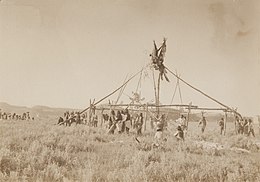|
Sun Dance The Sun Dance is a ceremony practiced by some Native Americans in the United States and Indigenous peoples in Canada, primarily those of the Plains cultures, as well as a new movement within Native American religions.[1][2][3][4] Members of otherwise independent bands gather to reaffirm beliefs about the world and the supernatural through rituals of personal and community sacrifice. Typically, young men would dance semi-continuously for several days and nights without eating or drinking; in some cultures self-mortification is/was also practiced.[5]   After European colonization of the Americas, and with the formation of the Canadian and United States governments, both countries passed laws intended to suppress Indigenous cultures and force assimilation to Christianity and majority-Anglo-American culture. The Sun Dance was one of the prohibited ceremonies, as was the potlatch of the Pacific Northwest peoples.[6] An attenuated form Canada lifted its prohibition against the practice of the full ceremony in 1951. In the United States, Congress passed the American Indian Religious Freedom Act (AIRFA) in 1978, which was enacted to protect basic civil liberties, and to protect and preserve the traditional religious rights and cultural practices of Native Americans, Eskimos, Aleuts, and Native Hawaiians.[7] Description Several features are common to the ceremonies held by Sun Dance cultures. These include dances and songs passed down through many generations, the use of a traditional drum, a sacred fire, praying with a ceremonial pipe, fasting from food and water before participating in the dance, and, in some cases, the ceremonial piercing of skin and trials of physical endurance. Certain plants are picked and prepared for use during the ceremony, such as Artemisia ludoviciana (white sage), which the Lakota use to make bracelets.[8] Typically, the Sun Dance is a grueling ordeal for the dancers, a physical and spiritual test that they offer in sacrifice for their people. According to the Oklahoma Historical Society, young men dance around a pole to which they are fastened by "rawhide thongs pegged through the skin of their chests."[9] Piercing was accomplished using skewers or piercing needles through a small fold of skin on the upper chest or back; leather was then used to attach a bison skull or other heavy weight to the skewers. A dancer would dance while bearing the weight until he collapsed or the skin was torn loose.[5] At most ceremonies, family members and friends stay in the surrounding camp and pray in support of the dancers. Communities plan and organize for at least a year to prepare for the ceremony. Usually, one leader or a small group of leaders are in charge of the ceremony, but many elders help out and advise. CanadaThe Government of Canada, through the Department of Indian Affairs (now Crown–Indigenous Relations and Northern Affairs Canada), persecuted Sun Dance practitioners and attempted to suppress the dance. Indian agents, based on directives from their superiors, routinely interfered with, discouraged, and disallowed sun dances in many Canadian plains communities from 1882 until the 1940s.[citation needed] The Canadian government outlawed "any celebration or dance of which the wounding or mutilation of the dead or living body of any human being or animal forms a part or is a feature" in an 1895 amendment to the Indian Act.[10] Anyone who engaged, assisted or encouraged (either directly or indirectly) was liable to imprisonment.[10] Though not all nations' Sun Dances include the body piercings, the amendment legally prohibited its performance for those communities that did.[citation needed] It is unclear how often this law was actually enforced; in at least one instance[when?], police are known to have given their permission for the ceremony to be conducted.[citation needed] The First Nations people simply conducted many ceremonies quietly and in secret. Sun dance practitioners, such as the Plains Cree, Saulteaux, and Blackfoot, continued to hold sun dances throughout the persecution period. Some practiced the dance in secret, others with permissions from their agents, and others without the body piercing.[citation needed] In 1951, government officials amended the Indian Act, dropping the prohibition against practices of flesh-wounding.[11][12] Contemporary practicesThe Sun Dance is living tradition[4] practiced annually in many Native communities in Canada and the U.S. The Cree and Saulteaux have conducted at least one Rain Dance (with similar elements) each year since 1890 somewhere on the Canadian Plains.[citation needed] In 1993, responding to what they believed was a frequent desecration of the Sun Dance and other Lakota sacred ceremonies, US and Canadian Lakota, Dakota and Nakota nations held "the Lakota Summit V". It was an international gathering of about 500 representatives from 40 different peoples and bands of the Lakota. They unanimously passed the following 'Declaration of War Against Exploiters of Lakota Spirituality':
In 1995, efforts to continue practicing the ceremony on a tract of unceded Secwepemc land led to an armed confrontation known as the Gustafsen Lake standoff. In 2003, the 19th-Generation Keeper of the Sacred White Buffalo Calf Pipe of the Lakota asked non-Indigenous people to stop attending the Sun Dance (Wi-wayang-wa-c'i-pi in Lakota); he stated that all can pray in support, but that only Indigenous people should approach the altars.[15] This statement was supported by keepers of sacred bundles and traditional spiritual leaders from the Cheyenne and Sioux who issued a proclamation that non-Indigenous people would be banned from sacred altars and the Seven Sacred Rites, including and especially the sun dance, effective March 9, 2003 onward:
FilmingIn most Sun Dance cultures, it is forbidden to film ceremony or prayer. Few images exist of authentic ceremonies. Many First Nations people believe that when money or cameras enter, the spirits leave, so no photo conveys an authentic ceremony. To much disdain, the Kainai Nation in Alberta permitted filming of their Sun Dance in the late 1950s for the sake of its preservation. This was released as the documentary Circle of the Sun (1960), produced by the National Film Board of Canada.[16][17] Manitoba archival photos show that the ceremonies have been consistently practiced since at least the early 1900s. See alsoWikimedia Commons has media related to Sun Dance.
References
|
